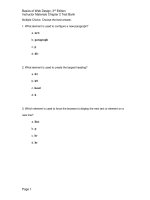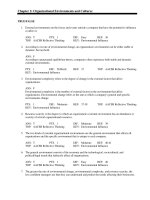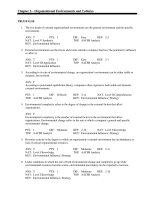Computer security fundamentals 2nd edition william chuck easttom test bank
Bạn đang xem bản rút gọn của tài liệu. Xem và tải ngay bản đầy đủ của tài liệu tại đây (261.36 KB, 8 trang )
CHAPTER 2: NETWORKS AND THE INTERNET
Multiple Choice
1. What type of cable do most networks use?
A.
Net cable
B.
Category 3 cable
C.
Phone cable
D.
Category 5 cable
The answer is D
2. The connector used with network cables is called what?
A.
RJ-11
B.
RJ-85
C.
RJ-12
D.
RJ-45
The answer is D
3. The cable used in networks is also referred to as what?
A.
Unshielded twisted pair
B.
Shielded twisted pair
C.
Unshielded untwisted pair
D.
Shielded untwisted pair
The answer is A
4. The simplest device for connecting computers is called what?
A.
NIC
B.
Interface
C.
Hub
D.
Router
1
The answer is C
5. What is a NIC?
A.
Network interface card.
B.
Network interaction card
C.
Network interface connector
D.
Network interaction connector
The answer is A
6. A device used to connect two or more networks together is a what?
A.
Switch
B.
Router
C.
Hub
D.
NIC
The answer is B
7. A T1 line sends data at what speed?
A.
100Mbps
B.
1.54Mbps
C.
155Mbps
D.
56.6Kbps
The answer is B
8. How big is a TCP packet header?
A.
The size is dependent on the data being sent.
B.
The size is always 20 bytes.
C.
The size is dependent on the protocol being used.
D.
The size is always 40 bytes.
The answer is B
9. A protocol that translates web addresses into IP addresses is called what?
A.
DNS
B.
TFTP
C.
DHCP
2
D.
SMTP
The answer is A
10.What protocol is used to send email, and on what port does it work?
A.
SMTP, port 110
B.
POP3, port 25
C.
SMTP, port 25
D.
POP3, port 110
The answer is C
11.What protocol is used for remotely logging on to a computer?
A.
Telnet
B.
HTTP
C.
DNS
D.
SMTP
The answer is A
12.What protocol is used for web pages, and what port does it work on?
A.
HTTP, port 21
B.
HTTP, port 80
C.
DHCP, port 80
D.
DHCP, port 21
The answer is B
13.The point where the backbones of the Internet connect is called what?
A.
Connectors
B.
Routers
C.
Network access points
D.
Switches
The answer is C
14.Which of the following is not a valid IP address?
A.
127.0.0.1
B.
295.253.254.01
3
C.
127.256.5.2
D.
245.200.11.1
The answer is B
15.What class would the IP address of 193.44.34.12 be?
A.
A
B.
B
C.
C
D.
D
The answer is C
16.The IP address of 127.0.0.1 always refers to your what?
A.
Nearest router
B.
ISP
C.
Self
D.
Nearest NAP
The answer is C
17.Internet addresses of the form www.chuckeasttom.com are called what?
A.
User-friendly web addresses
B.
Uniform resource locators
C.
User-accessible web addresses
D.
Uniform address identifiers
The answer is B
18.Which U.S. government agency created the distributed network that formed the
basis for the Internet?
A.
Advanced Research Projects Agency
B.
Central Intelligence Agency
C.
NASA
D.
Department of Energy
The answer is A
4
19.Which of the following was one of the three universities involved in the original
distributed network setup by a government agency?
A.
Berkeley
B.
Harvard
C.
MIT
D.
Princeton
The answer is A
20.Vince Cerf invented what?
A.
The World Wide Web
B.
C.
TCP
D.
The first computer virus
The answer is C
The answer is A
21.Tim Berners-Lee invented what?
A.
The World Wide Web
B.
C.
TCP
D.
The first computer virus
The answer is A
22.Which utility gives you information about your machine’s network configuration?
A.
Ping
B.
IPConfig
C.
Tracert
D.
MyConfig
The answer is B
23.The TCP protocol operates at what layer of the OSI model?
A.
Transport
B.
Application
C.
Network
5
D.
Data link
The answer is A
24.Which layer of the OSI model is divided into two sublayers?
A.
Data link
B.
Network
C.
Presentation
D.
Session
The answer is A
25.A unique hexadecimal number that identifies your network card is called what?
A.
A NIC address
B.
A MAC address
C.
A NIC ID
D.
A MAC ID
The answer is B
Fill in the Blank:
1.
A(n) ____________ is a card that allows a computer to connect to another computer or to a network.
Answer: Network Interface Card (NIC) Reference: Network Basics
2.
The ____________ is the method that a secondary DNS server uses to update its information from the
primary DNS server.
Answer: zone transfer Reference: DNS Servers
3.
Reference: The Physical Connection: Local Networks
Reference: The Physical Connection: Internet
Reference: IP Addresses
Difficulty: easy
____________, a commonly used DOS command, sends a test packet to determine whether a machine is
reachable.
Answer: Ping
7.
Difficulty: moderate
A(n) ____________ is a special IP number (127.0.0.1) that designates the machine you are on regardless of
its IP address.
Answer: loop back address
6.
Difficulty: easy
The basic purpose of a cable is to transmit ____________ from one machine to another.
Answer: packets
5.
Difficulty: moderate
The number of bits that a cable can transmit is called ____________.
Answer: bandwidth
4.
Difficulty: easy
Reference: Basic Network Utilities
Difficulty: easy
The purpose of a ______________ is to hide your network from the outside world.
6
Answer: proxy server
Reference: Other Network Devices
Difficulty: easy
Matching:
8.
Match the following terms to their meanings:
I.
Application A. Connects the entity to the transmission media
II.
Presentation B. Provides end-to-end communication control
III. Session
C. Handles problems that are not communication issues
IV. Transport
D. Converts the information
V.
E. Provides error control between adjacent nodes
Network
VI. Data link
F. Routes the information in the network
VII. Physical
G. Provides different services to the applications
Answer: G D C B F E A
9.
Reference: The OSI Model
Match the following terms to their meanings:
I.
Domain Name Server (DNS) A. Holds duplicate URL/IP information
II.
Primary DNS
B. Sends changes from one server to another
III. Secondary DNS
C. Holds the master copy of URL/IP information
IV. Zone transfer
Answer: D C A B
10.
D. Translates domain names into IP addresses
Reference: DNS Servers
Difficulty: moderate
Match the following cable types and their uses:
I.
Analog
II.
Up to 20 MHz /16 Mbps B. Telephone
A. Voice transmission
III. 100 MHz/100 Mbps
C. High-speed networks
IV. 250 MHz/1,000 Mbps
D. Standard speed networks
Answer: B A D C
11.
Difficulty: hard
Reference: The Physical Connection: Local Networks
Match the following terms to their meanings:
I.
TCP A. Protocol that specifies the format and addressing scheme of a packet
II.
IP
B. Protocol used to extract error and control messages
III. UDP C. Protocol that establishes a connection for the exchange of data
IV. ICMP
Answer: C A D B
12.
Difficulty: moderate
D. Protocol that does not guarantee delivery of packets
Reference: Data Transmission Difficulty: moderate
Match the following code series message to their meaning:
I.
100 series
A. Messages refer to client errors
II.
200 series
B. Messages are simply informational
III. 300 series
C. Messages refer to server errors
IV. 400 series
D. Messages indicate successful connections
7
V.
500 series
Answer: B D E A C
13.
E. Messages indicate that the Web site has moved
Reference: Uniform Resource Locators Difficulty: hard
Match the following terms to their meanings:
I.
Ping A. Shows how many hops a packet needs to reach a host and the length of time
II.
flag B. Gives information about your connection to the Internet
II.
IPConfig
III. Tracert
way
Answer: C D B A
C. Used to send a test packet and determine whether an IP address is reachable
D. Parameters that can be passed to commands to make the computer behave in a certain
Reference: Basic Network Utilities
8
Difficulty: easy









